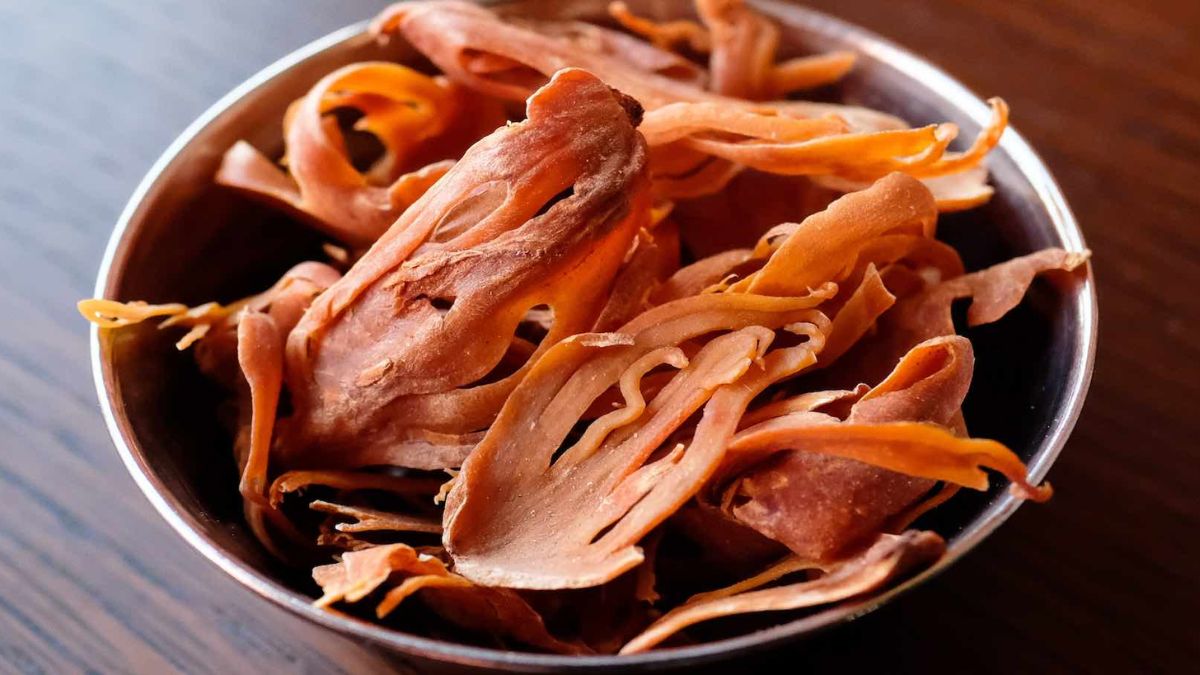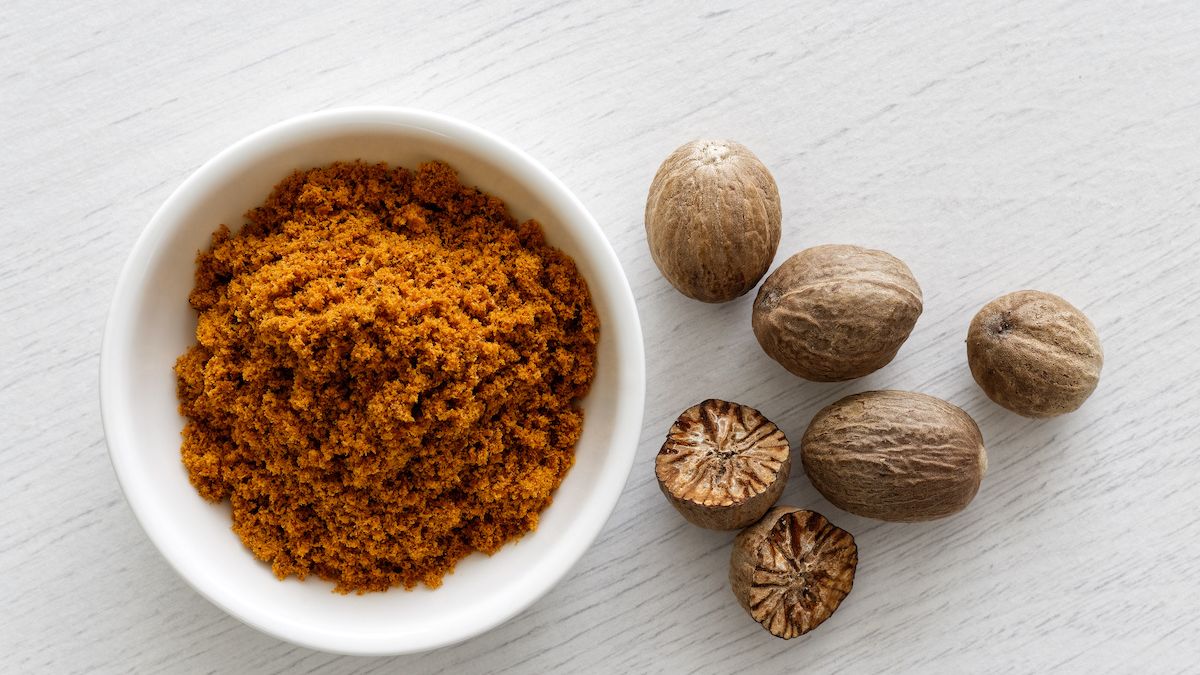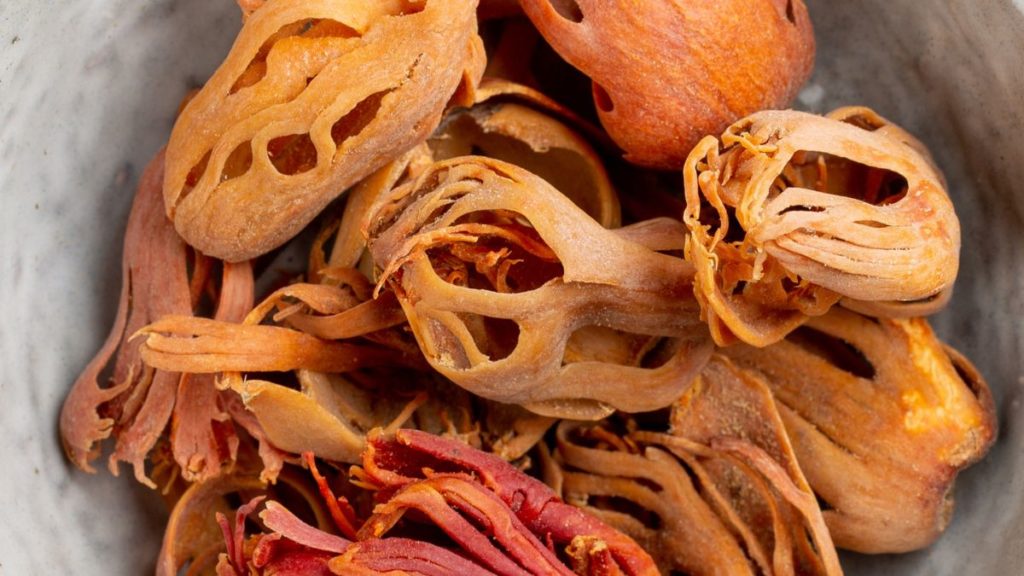The dried lacy coating of the nutmeg seed is the source of Mace, a yellowish-brown spice. It is frequently combined with other aromatic spices and is available in both ground form and as dried “blades.” In addition to being used in British, Dutch, and French cooking, Mace is a key ingredient in the cuisines of Asia, the Caribbean, India, and Morocco. It is frequently used in savory foods like soups, sauces, and recipes for fowl and fish, as well as in baked goods and spice blends. There is no connection between the spice and the “mace” used as a protective pepper spray.
When handled properly and consumed by mouth, Mace is possibly safe. Spices like Mace are frequently used in dishes. When eaten in doses greater than those found in food, Mace is possibly unsafe. Myristicin, a substance found in Mace related to hallucinations and other mental adverse effects, is present in Mace. Many other spice blends contain maces, such as curry powder, garam masala, and ras el hanout. It can be used in pickling recipes or to impart flavor, like with a bay leaf, in baked products, including donuts, cakes, puddings, and custards.
What is Mace?
The Myristica fragrans nutmeg tree is a tropical evergreen that yields Mace and Nutmeg. The nutmeg seed’s scarlet lacy covering, known as the aril, is known as Mace. The aril and seed are visible when the tree’s fruit splits open at maturity. The aril is manually plucked from the fruit after it has been harvested, flattened, and let to dry outside for 10 to 14 days.
When left whole, the red aril is referred to as a “blade” of Mace. As it dries, the red aril turns an amber, yellow, or orange-brown tint. The blades can be used as-is or ground into a spice. In addition to some Caribbean islands, including Grenada, where Nutmeg is the national emblem and is depicted on the flag, Mace is a native of Indonesia.
Mace is the lace-like scarlet membrane, also known as the aril, that covers the exterior of the nutmeg seed and is derived from the tropical nutmeg tree, also known as Myristica fragrans. When ripe, the fruit breaks apart and falls off the tree, exposing the aril and seed. To make Mace, the aril is carefully removed from the outside of the plant, flattened, and placed outside to dry for up to two weeks. The more well-known member of Mace’s family, Nutmeg, is the seed inside. Mace is used as whole dried pieces and as a powder like a nutmeg.
Varieties of Mace
Determine the country of origin of the Mace by looking at the color of the spice. Orange-yellow blades probably originate from Grenada, but orange-red blades typically come from Indonesia.
What does it Taste Like?
Like Nutmeg but softer and less sweet, Mace has a sweet, woodsy, toasty flavor with a faint spicy kick. Mace’s flavor can also be compared to a blend of cinnamon and pepper. Like Nutmeg but softer and less sweet, Mace has a sweet, woodsy, toasty flavor with a faint spicy kick. Mace’s flavor can also be compared to a blend of cinnamon and pepper. Since Nutmeg is so widely available, recipes frequently call for it instead of Mace. Additionally, Mace tastes hotter and stronger than Nutmeg; Mace tastes a lot like black pepper.
Mace tastes warm, citrus-like, sweet, spicy, and sweet, comparable to Nutmeg but less potent. Due to its delicate aroma, it goes well with poultry, sweet new-season vegetables, fish, and seafood meals.
How to Cook with Mace?
Grounded Mace is called for in most recipes. It can be used straight from the jar with no preparation necessary. Like ground nutmeg, you can add it to a dry spice blend, use it in a recipe, or sprinkle it on top of desserts, oatmeal, or drinks.
Using a mortar and pestle or a spice grinder, mace blades are simple to grind. The essential oils are awakened for a more fragrant spice by lightly toasting the blades and letting them cool before grinding. This also helps prevent the oils from clogging a spice grinder. It is typical to toast other whole spices like cardamom and cloves while toasting mace blades in a dry pan until crispy and fragrant.
Recipes with Mace
Many other spice blends contain maces, such as curry powder, garam masala, and ras el hanout. It can be used in pickling recipes or to impart flavor, like with a bay leaf, in baked products, including donuts, cakes, puddings, and custards. The spice can also be used in cheese dishes, sauces, soups, and recipes for poultry and fish. It goes especially well with foods that contain cherries or chocolate. The blades can also flavor rice, steamed food, stocks, or other liquid-based foods that require lengthy cooking.
What are the Substitutions?
Although Nutmeg has a stronger flavor, it can be used in place of Mace in recipes. Using a bit less Nutmeg in some recipes can be better to preserve a balanced flavor. Ground allspice is the next best substitute for ground mace. Reduce the recipe quantity by half and add more if necessary because it has a similar flavor profile but is much stronger.
Additionally, ground cinnamon and ginger are good possibilities for some dishes where the flavor difference won’t take away from the meal. Comparable to how a pumpkin pie spice blend may work well to replace all of the spices in a dish that calls for Mace, cinnamon, ginger, and allspice (or other similar aromatic spices).
Mace is more difficult to locate and expensive than other more traditional spices because it isn’t as popular or frequently used in recipes as previously. The flavor of your meal won’t turn out the same if you swap Nutmeg for Mace (or Mace for Nutmeg) in a one-to-one ratio because the two spices don’t taste the same. In addition, ground allspice can be used in place of ground mace.
Where to Buy Mace?
Mace costs more than the other widely used fragrant spices, especially the blades. While mace blades can be discovered in exotic food markets, spice shops, and stores with a broader selection of premium spices, ground mace is frequently accessible in the spice department of many grocery stores and supermarkets. However, it is also available through online merchants, either whole or ground. You can purchase Mace from physical merchants like The Home Security Superstore or sports goods stores with some limitations.
Whole vs. Ground
Although Mace is sometimes found in full pieces called blades, the ground form is more typical. Like Nutmeg, buying entire mace blades and grinding them as needed will give you the greatest flavor. However, ground mace retains its flavor longer and better than other spices, including ground nutmeg. One tablespoon of mace blades is equivalent to one teaspoon of ground mace when moving between the two forms.
How to Store Mace?
To make sure Mace is constantly fragrant and flavorful, avoid storing it in the refrigerator and think about purchasing only a small amount at a time. When properly stored in a jar or container that is well sealed and kept in a cold, dark location, Mace has a longer shelf life than the majority of other spices. While blades and ground mace may lose some of their power after six to eight months, both should retain their flavor for up to a year. Mace blades that emit a small amount of oil when squeezed with a fingernail are still considered fresh even though they have dried.
Origins
The evergreen Myristica fragrans tree is native to Indonesia’s Moluccas Islands, often known as the Spice Islands. This plant is widely cultivated throughout other tropical areas, from China to Sri Lanka, the Caribbean, and South America. Although it was stated that Mace was brought to Europe by Arab traders in the 12th century, the thriving spice trade of the 16th century made it more widely available worldwide, along with cloves, Nutmeg, and black pepper.
Conclusion
Vitamins A and C, iron, carotenoids, calcium, copper, and magnesium are all present in Mace. Mace and other energizing, warming spices can help digestion and jump-start our metabolisms. Studies have also shown that Mace is beneficial in reducing bodily inflammation and helping with digestive problems like diarrhea. Mace’s subtle sweetness lessens the need for additional added sugar.
The combination of Mace and fruit, particularly ripe fruit with strong floral smells like peaches and raspberries, is my favorite. But I’ve also been using Mace instead of Nutmeg in pastry for a lighter flavor that seems to go better with butter and cream. Your evening cocktail or punch would benefit from the addition of Mace. Nutmeg may be the most appropriate spice for a powerful rum, but I’ve appreciated Mace in drinks with luxurious yet floral whiskies.


